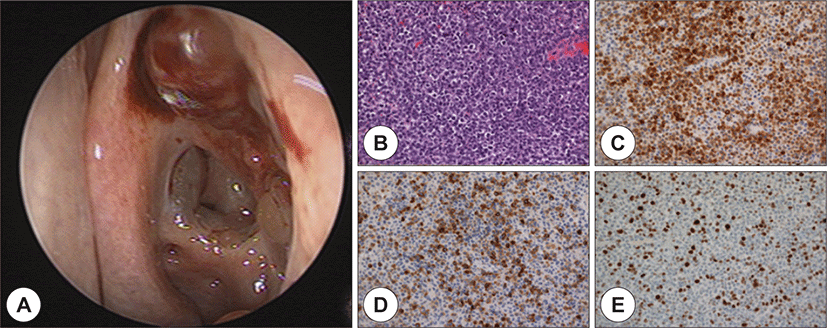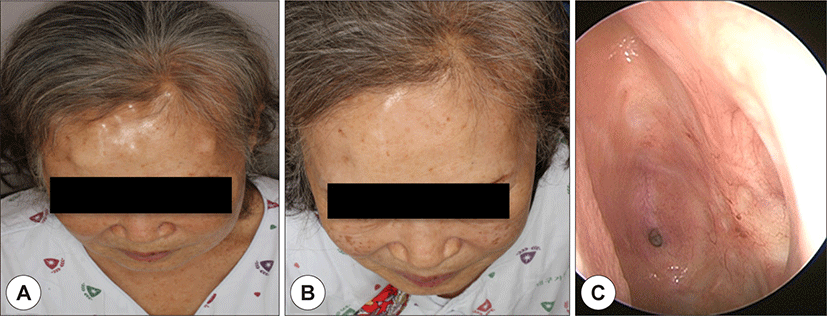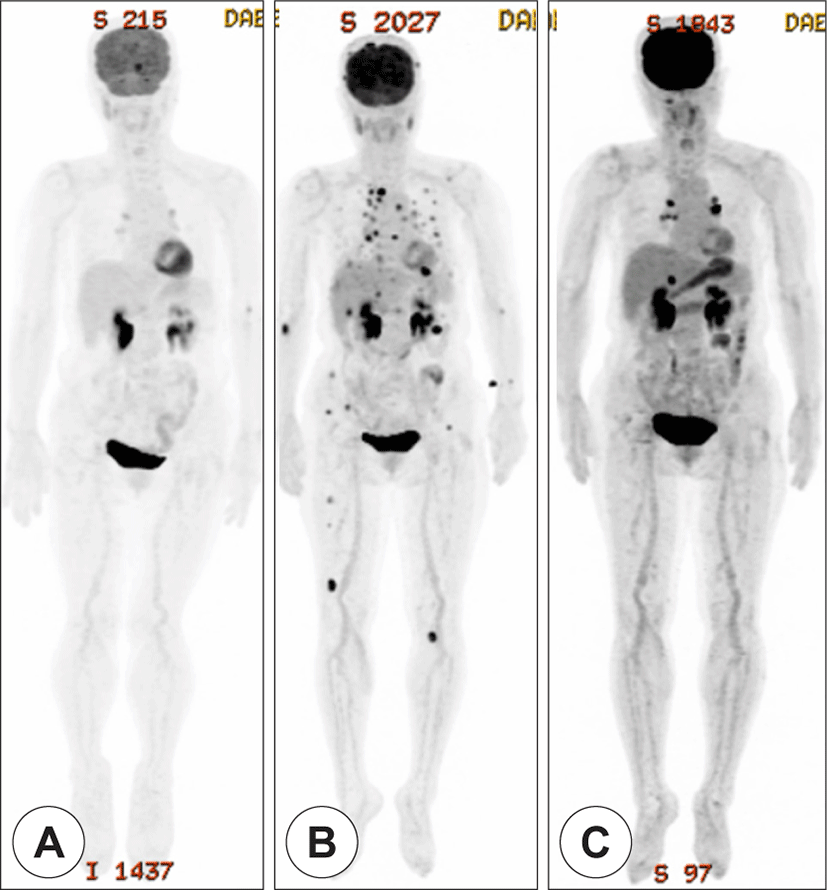서 론
점막 흑색종은 악성 흑색종의 약 1%를 차지하는 질환으로 그 중 50%는 두경부 영역에서 발생하며, 비부비동에서 발생하는 점막 흑색종은 두경부 영역의 4%-10%를 차지한다.1) 점막 흑색종은 높은 국소 재발과 원격 전이를 동반하는 피부 악성 흑색종과 다른 병태생리학적 특성을 가진다.2) 적절한 범위의 절제가 최선의 치료 방법이지만 높은 재발로 인해 5년 생존률은 0%-20%에 불과하다.3) 비부비동 점막 흑색종은 60대 이상의 여성에서 호발하며 특별한 증상이나 위험인자가 없어 진단이 늦게 이루어져 예후가 더욱 좋지 않다. 원격전이가 동반된 경우, 종양의 공격적인 생물학적 특성으로 인해 효과적으로 치료할 수 있는 방법이 확립되어 있지 않았으나, 최근 악성 흑색종의 치료 효과를 가지는 면역치료법이 사용되고 있다.4,5)
저자들은 좌측 비부비동에서 발생한 흑생종의 수술적 제거 후 발생한 국소 재발 및 원격 전이를 동반한 환자에서 programmed death-1(PD-1) 단클론항체을 이용한 면역치료를 시행하여 성공적으로 치료할 수 있었던 점막 흑색종 1예를 치험하였기에 문헌고찰과 함께 보고하는 바이다.
증 례
환자는 70세 여자로 2개월 전부터 간헐적으로 반복되는 좌측 비출혈로 개인 의원을 방문하여 내원 1개월 전 비용성 부비동염으로 진단하에 좌측 부비동 내시경수술을 시행하였으며, 조직검사에서 악성종양이 의심되어 본원으로 전원되었다. 외래에서 시행한 비내시경 검사에서 좌측 전두와 부근에 검붉은 종괴가 확인되어서 조직검사를 시행하였다(Fig. 1A). 면역조직화학염색에서 S-100, vimentin과 anti-melanoma marker antibody(HMB45)에 양성을 보였으며, Ki-67은 33.9%로 점막 흑색종으로 진단되었다(Fig. 1B, 1C, 1D and 1E). Fluoro-deoxy-D-glucose positron emission tomography computed tomography(FDG-PET/CT)에서 전두와와 전두동 부위에 병변이 확인되었으며, 기타 국소 혹는 원격 전이는 보이지 않았다(Fig. 3A). 종양의 광범위 절제와 술 후 방사선 치료를 계획하였으며, 수술은 좌측 전두동, 사골동, 상악동의 점막 제거를 위해 부비동 내시경수술과 골성형피판술(osteoplastic flap)을 병행하여 시행하였다. 방사선 치료는 총 방사선량 6,600 cGy의 계획하에 술 후 6주째부터 시작하였으며, 방사선 치료 11회째 골성형피판술을 시행한 이마 부위에 다수의 결절이 발견되어 조직검사를 시행하여 전이성 흑색종으로 확인되었다(Fig. 2A). 다시 시행한 FDG-PET/CT에서 이마 부위뿐 아니라, 폐와 간 부위 전이, 양측 어깨뼈(scapula), 복장뼈(sternum), 양측 갈비뼈, 장골(ilium) 등의 골부 전이와 좌측 흉부, 양측 팔, 궁둥이 부위의 피하 전이를 확인할 수 있었다(Fig 3B). 술 후 3개월째 방사선 치료를 중단하고 다학제 진료를 진행하여 혈액종양내과에서 PD-1 단클론항체 치료제인 nivolumab을 사용하기로 하였다. 면역치료 시행 2개월 후 이마 부위의 병변이 사라졌으며(Fig. 2B), 면역치료 시행 12개월 후 시행한 비강 내시경검사와 FDG-PET/CT에서 기존에 확인되었던 국소 혹은 원격전이 병변은 모두 확인되지 않았다(Fig. 2C and 3C). 면역치료를 총 24개월 시행하였으며, 면역치료에 의한 피부 색소 침착의 감소에 의한 백반증 외에 특별한 이상 증상없이 추적 관찰 중이다.



고 찰
비부비동 점막에서 발생하는 흑색종은 비부비동 악성 종양의 7%를 차지하며, 두경부 영역의 악성 흑색종의 4%-10% 정도를 차지하는 흔치 않은 질환이다.1,6) 부비동 내에서 발생한 점막 흑색종의 경우 여러 해부학적 구조물들과 안구나 두개저와 같은 위험한 구조물들을 침범하는 경우가 25% 정도이며, 종양 발견 초기에 지역 혹은 원격전이를 동반하는 경우는 6% 정도로 알려져 있다.7) 충분한 여유를 가지고 절제를 하는 것이 최선의 치료방법이지만, 수술 후에 빈번한 재발과 원격 전이로 인해 예후가 좋지 않다. 이를 개선하기 위해 높은 면역원성(immunogenicity)를 가지는 악성 흑색종의 특성을 이용한 면역치료가 새로운 치료법으로 선택되고 있다. 면역치료는 사이토카인이나 인터페론 등을 사용하는 생물학적 치료, 펩타이드나 유전자 등을 이용한 백신요법, lymphokine activated killer 등과 같은 면역세포를 이용한 세포 면역요법, 그리고 단클론항체를 이용한 면역관문억제제를 사용하는 4가지 치료법이 제안되었다.8–11) Cytotoxic T-lymphocyte antigen-4(CTLA-4)와 programmed death-ligand 1(PD-L1)과 같은 면역관문억제제의 사용으로 점막 흑색종의 생존률이 향상되고 있으며,12,13) PD-1/PD-L1의 상호작용을 차단하는 단클론항체 치료제가 CTLA-4 치료제보다 효과가 좋은 것으로 알려져 있으며, CTLA-4와 PD-L1 치료제의 병용요법은 단독요법보다 치료 결과가 좋은 것으로 알려져 있다.14,15) 본 증례의 경우, 수술적 치료 후에 급속히 진행된 안면 부위의 국소 전이와 폐, 간, 뼈 등으로의 전신 전이를 동반한 환자에서 PD-1 억제제인 nivolumab을 이용한 전신요법으로 우수한 치료 효과를 얻을 수 있었다.
점막 흑색종의 경우, BRAF 돌연변이는 매우 드물게 나타나며, 본 증례의 경우에도 조직내 BRAF 돌연변이 검사에서 음성임을 확인하여 BRAF 억제를 위한 면역치료는 시행하지 않았다. CTLA-4 억제제와 PD-1 억제제는 미국식품의약국으로부터 전이성 흑색종의 치료제로 승인을 받아 사용 중이다. CTLA-4 억제제의 단독 사용으로 흑색종의 10년 생존율을 22%까지 향상시켰으며, PD-1 억제제의 사용으로 34%의 환자에서 치료 효과를 보였으며, 치료 중단 후에도 3개월 이상 치료 효과가 지속되는 것으로 알려져 있다.4,16) 일반적으로 PD-1억제제가 CTLA-4 억제제보다 효과가 좋으며, 조직내 PD-L1의 발현의 여부와 무관하게 PD-1 억제제는 점막 흑색종에 치료 효과를 가진다.5,15) 하지만 이들 면역치료제는 피부, 위장관, 호흡기, 내분비, 순환기 등 전신 부작용을 유발할 수 있다.17,18) 다양한 피부 부작용이 약 50%의 환자에서 나타나는데, 백반증이 나타나는 경우 종양의 치료효과가 좋으며, 높은 생존율을 보이는 것으로 알려져 있다.19) 본 증례의 경우도 면역치료 시행 3개월 후부터 피부 백반증이 나타나, 우수한 치료 효과를 보인 것으로 추측할 수 있다. 비부비동 점막 흑색종의 경우 5년 생존율은 33% 정도이며, 이후에도 생존율은 지속적으로 감소하여 15년 생존율은 14%에 불과하다.20) 본 증례의 경우, 진단 후 2년 7개월, 24개월간의 면역치료 종류 후 4개월이 경과한 현재까지 국소 재발이나 원격 전이는 발견되고 있지 않지만, 지속적인 추적 관찰이 필요할 것이다.
전이성 악성 흑색종은 예후가 좋지 않은 것으로 알려져 있다. 본 증례의 경우 비부비동에 국한된 점막 흑색종의 수술적 치료 후 급격히 발생한 국소 전이와 원격전이를 면역관문억제제 중의 하나인 PD-1 억제제를 이용한 전신요법으로 우수한 치료 효과를 확인할 수 있었다. 수술적 치료나 방사선 치료의 효과에도 불구하고, 국소 재발을 하거나 원격 전이가 동반되는 점막 흑색종의 치료에 면역관문억제제의 사용은 유용한 치료방법으로 선택될 수 있을 것이다.
